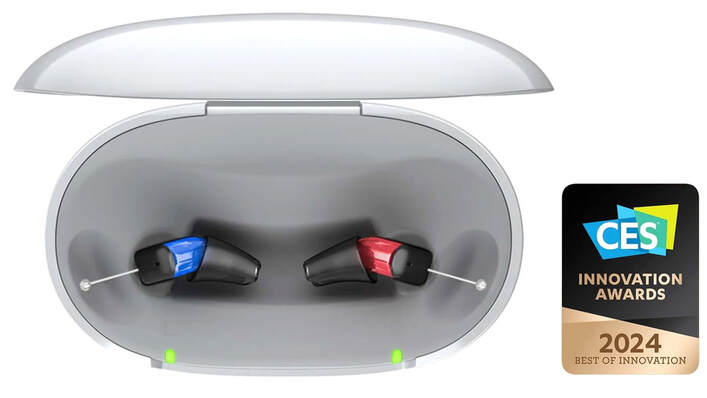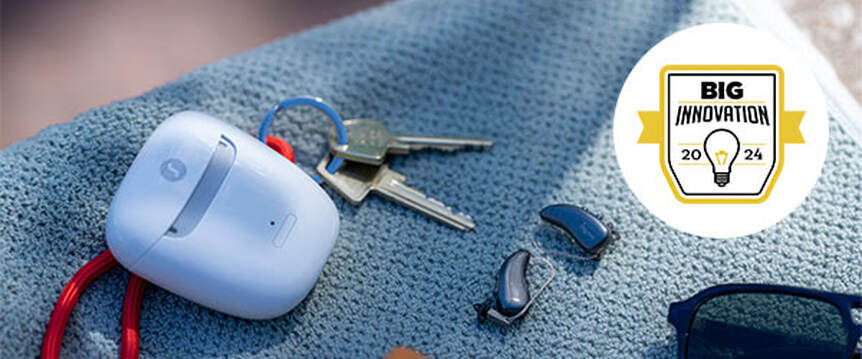|
In an exciting development for the hearing aid industry, Signia's Silk Charge&Go IX has been named a Best of Innovation honoree at the prestigious 2024 CES Innovation Awards. Signia is committed to offering cutting-edge hearing technology. One of their standout products in the Wearable Technologies category is the Silk Charge&Go IX. Hearing SolutionsUnveiled on November 22, 2023, in Iselin, NJ, the Silk Charge&Go IX is a revolutionary hearing aid built on Signia's Integrated Xperience platform. The new platform helps people improve their conversation skills, which is a significant advancement in the hearing aid industry Innovative Consumer Technology. Innovative Consumer TechnologyThe CES Innovation Awards celebrate brands that push the boundaries of innovation in consumer technology. Signia's Silk Charge&Go IX, recognized in the Wearable Technologies category, sets a new standard for hearing aids. This product helps people hear better in noisy group conversations or loud background noise. It ensures high-quality sound and clearness, even when they are on the move. First Rechargeable Hearing AidsAs the world's first and only rechargeable, instant-fit completely-in-the-canal (CIC) hearing aid, Silk Charge&Go IX offers a discreet design while delivering superior speech-in-noise performance. It is available as IX CROS for individuals with single-sided deafness. One of its standout features is the impressive 24-hour charge in a single session, catering to active wearers who rely on their hearing aids throughout the day. With Binaural OneMic Directionality 2.0 technology, The Silk Charge&Go IX hearing aid enhances speech comprehension in challenging environments, like noisy group discussions. This represents a significant advancement in hearing aid technology. Seamless Hearing Aid FittingThe instant-fit design makes the hearing aid fitting process seamless, and wearers have the option of customized earmolds. Additionally, Silk Charge&Go IX comes equipped with a built-in power bank for on-the-go charging, compatible with USB 3.0 and wireless Qi chargers. Quality Hearing SolutionNicholas Hort, Vice President of Marketing at Signia U.S., highlighted the impact of Signia Integrated Xperience and the Silk Charge&Go IX, stating, "The launch of Signia Integrated Xperience and the hearing aids supporting the platform has unleashed a new standard for hearing aid technology. Wearers deserve the best quality hearing possible to enjoy life to the fullest, and Silk Charge&Go IX delivers enhanced hearing that exceeds existing industry standards and wearer expectations." At Pure Sound Hearing Aids, we are ready to fit you with these innovative hearing aids. Call us today to schedule your free consultation with one of our expert hearing aid specialists.
Signs and symptoms of hearing lossEarly intervention is crucial for managing hearing loss. Finding and treating hearing loss early can help stop it from getting worse and causing more problems. Hearing loss can be difficult to notice as it happens gradually. This makes it challenging for individuals to recognize when their hearing has worsened. Recognizing signs of hearing loss and being attentive to changes in hearing ability is crucial.
ConclusionIf you or someone you know have these signs, it's important to see a hearing aid specialist for a hearing test. Contact Pure Sound Hearing Aids for a free hearing test. Early detection and intervention can significantly improve outcomes for individuals with hearing loss.
What is Dementia?
First things first, what's dementia? It's not a disease itself, but a term that covers various memory and thinking problems. Alzheimer's is a type of dementia, and there are others like vascular dementia and frontotemporal dementia. These conditions can make it tricky for our brains to work like they used to.
Hearing Loss and the Brain
Now, let's talk about hearing loss. Did you know that what happens in our ears is linked to our brains? It's like a team effort! When we can't hear well, our brains might have to work extra hard to understand what's going on around us. This extra effort might have a connection to dementia.
The Research Scoop
Scientists have been looking into this, and here's what they found. Some studies suggest that untreated hearing loss might speed up cognitive decline. It's like a puzzle where the pieces fit together – when our ears struggle, our brains might face more challenges too.
Communication Troubles
Imagine trying to understand a game without knowing the rules. That's how it can feel for someone with hearing loss. If they can't hear well, it might be tough for them to join conversations or follow what's happening. This can make them feel isolated, and that feeling of being alone can be linked to dementia.
What Can We Do to Take Care Of Our Ears & Brains?
In Conclusion
There you have it – the scoop on the link between dementia and hearing loss. Taking care of our ears and staying socially active are like superheroes for our brains. So, let's look out for our ears, be kind to our brains, and keep the good vibes going!
Contact or email us to schedule a free hearing consultation with one of our hearing care professionals. |
Categories
All
|
-
products
- Rexton Emerald M 8C RIC
- Rexton inoX CIC 8C
- Rexton Mosaic M 8C BTE
- Rexton Mosaic P 8C BTE
- Rexton Stellar RIC 8C
- Rexton Sterling 8C CIC / IIC
- Rexton Sterling 8C ITE / ITC
- Rexton Emerald XS 8C RIC
- Rexton Emerald S 8C RIC
- Signia Active Pro
- Signia CROS AX
- Signia CROS Hearing Solutions
- Signia Insio Charge&Go AX
- Signia Insio Nx IIC/CIC
- Signia Insio Nx ITC/ITE
- Signia Intuis 3 Family
- Signia Motion Charge&Go X
- Signia Motion 13 Nx/Motion 13 P Nx
- Signia Prompt
- Signia Pure Charge&Go AX & T AX
- Signia Pure 312 AX
- Signia Pure 10 Nx
- Signia Pure 13 BT
- Signia Pure 13 Nx
- Signia Silk X
- Signia Styletto AX
- Signia Styletto X
- SERVICES >
- about
- blog
- Insurance
- contact
|
© 2023 Pure Sound Hearing Aids. All Rights Reserved.
|
Proudly powered by Weebly
-
products
- Rexton Emerald M 8C RIC
- Rexton inoX CIC 8C
- Rexton Mosaic M 8C BTE
- Rexton Mosaic P 8C BTE
- Rexton Stellar RIC 8C
- Rexton Sterling 8C CIC / IIC
- Rexton Sterling 8C ITE / ITC
- Rexton Emerald XS 8C RIC
- Rexton Emerald S 8C RIC
- Signia Active Pro
- Signia CROS AX
- Signia CROS Hearing Solutions
- Signia Insio Charge&Go AX
- Signia Insio Nx IIC/CIC
- Signia Insio Nx ITC/ITE
- Signia Intuis 3 Family
- Signia Motion Charge&Go X
- Signia Motion 13 Nx/Motion 13 P Nx
- Signia Prompt
- Signia Pure Charge&Go AX & T AX
- Signia Pure 312 AX
- Signia Pure 10 Nx
- Signia Pure 13 BT
- Signia Pure 13 Nx
- Signia Silk X
- Signia Styletto AX
- Signia Styletto X
- SERVICES >
- about
- blog
- Insurance
- contact





 RSS Feed
RSS Feed